Greater Buenos Aires
Greater Buenos Aires (Spanish: Gran Buenos Aires, GBA), also known as the Buenos Aires Metropolitan Area (Spanish: Área Metropolitana de Buenos Aires, AMBA),[2] refers to the urban agglomeration comprising the autonomous city of Buenos Aires and the adjacent 24 partidos (districts) in the Province of Buenos Aires. Thus, it does not constitute a single administrative unit. The conurbation spreads south, west and north of Buenos Aires city. To the east, the River Plate serves as a natural boundary.
Gran Buenos Aires | |
|---|---|
| Greater Buenos Aires | |
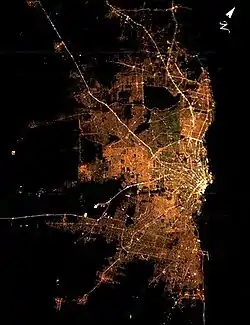 Satellite image of Greater Buenos Aires at night | |
| Country | |
| Core city | Buenos Aires |
| Area | |
| • Metro | 3,830 km2 (1,480 sq mi) |
| Population | 12,801,365 (24 partidos plus Federal District) |
| • Metro | 13,641,973 (including partidos not yet conurbated) |
| • Metro density | 3,342.39/km2 (8,656.8/sq mi) |
Urban sprawl, especially between 1945 and 1980, created a vast conurbation of 9,910,282 inhabitants in the 24 conurbated partidos, as of 2010, and a total of 12,801,365 including the City of Buenos Aires, a third of the total population of Argentina and generating more than half of the country's GDP.
History
The term Gran Buenos Aires ("Greater Buenos Aires") was first officially used in 1948, when Governor of Buenos Aires Province Domingo Mercante signed a bill delineating as such an area covering 14 municipalities surrounding the City of Buenos Aires.[3] The term is also related to other expressions that are not necessarily well-defined: the "Buenos Aires' conurbation" (Conurbano Bonaerense), the "Greater Buenos Aires Agglomeration" (Aglomerado Gran Buenos Aires), and the "Metropolitan Area of Buenos Aires" (Área Metropolitana Buenos Aires, AMBA).
Definition


The National Institute of Statistics and Censuses (INDEC) has defined Greater Buenos Aires.[4] There are three main groups within the Buenos Aires conurbation. The first two groups (24 partidos) comprise the traditional conurbation, or the "conurbation proper", while the third group of six partidos is in the process of becoming fully integrated with the rest.
- Fourteen fully urbanized partidos
- Ten partidos partially urbanized
- Six partidos not yet conurbated
As urbanization continues and the conurbation grows, six additional partially urbanized partidos now are fully connected with the conurbation:
| Rank | Partido | Seat | 2010 Census[5] | % growth from 2001 Census[5] |
|---|---|---|---|---|
| * | Buenos Aires | 2,890,151 | 4.1 | |
| 1 | La Matanza | San Justo | 1,775,816 | 41.5 |
| 2 | Lomas de Zamora | Lomas de Zamora | 616,279 | 4.2 |
| 3 | Quilmes | Quilmes | 582,943 | 12.4 |
| 4 | Almirante Brown | Adrogué | 552,902 | 7.2 |
| 5 | Merlo | Merlo | 528,494 | 12.4 |
| 6 | Lanús | Lanús | 459,263 | 1.4 |
| 7 | Moreno | Moreno | 452,505 | 18.9 |
| 8 | Florencio Varela | Florencio Varela | 426,005 | 22.1 |
| 9 | General San Martín | San Martín | 414,196 | 2.8 |
| 10 | Tigre | Tigre | 376,381 | 25.0 |
| 11 | Avellaneda | Avellaneda | 342,677 | 4.2 |
| 12 | Tres de Febrero | Caseros | 340,071 | 1.1 |
| 13 | Berazategui | Berazategui | 324,344 | 12.6 |
| 14 | Malvinas Argentinas | Los Polvorines | 322,375 | 10.9 |
| 15 | Morón | Morón | 321,109 | 3.8 |
| 16 | Esteban Echeverría | Monte Grande | 300,959 | 23.4 |
| 17 | San Isidro | San Isidro | 292,878 | 0.5 |
| 18 | San Miguel | San Miguel | 276,190 | 9.1 |
| 19 | Vicente López | Olivos | 269,420 | -1.7 |
| 20 | José C. Paz | José C. Paz | 265,981 | 15.5 |
| 21 | Hurlingham | Hurlingham | 181,241 | 5.2 |
| 22 | Ituzaingó | Ituzaingó | 167,824 | 6.1 |
| 23 | Ezeiza | Ezeiza | 163,722 | 37.8 |
| 24 | San Fernando | San Fernando | 163,240 | 8.0 |
List of cities in Greater Buenos Aires

Gallery
 Berazategui
Berazategui Ciudad Evita (La Matanza Partido)
Ciudad Evita (La Matanza Partido)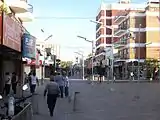 Florencio Varela
Florencio Varela General San Martín
General San Martín Monte Grande (Esteban Echeverría Partido)
Monte Grande (Esteban Echeverría Partido)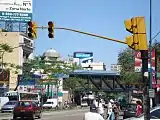 Olivos (Vicente López Partido)
Olivos (Vicente López Partido) Quilmes
Quilmes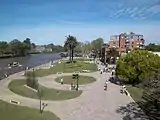 Tigre
Tigre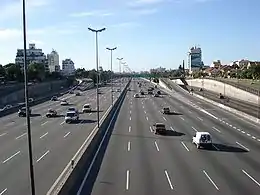 Pan-American Expressway, north of Buenos Aires
Pan-American Expressway, north of Buenos Aires
References
- "2010 Census provisional results". Archived from the original on 2012-09-01. Retrieved 2011-03-07.
- "¿Qué significa AMBA, el área más estricta con la cuarentena en Argentina?". La Nación (in Spanish). June 18, 2020. Retrieved June 21, 2020.
- Alicia Novick & Horacio Caride. "Ciudad versus área metropolitana. Notas para una historia del gran Buenos Aires".
- "¿Qué es el Gran Buenos Aires?" (PDF) (Press release) (in Spanish). National Institute of Statistics and Censuses. 2003-08-01. Archived from the original (PDF) on 2008-09-11. Retrieved 2008-06-28.
- "Provincia de Buenos Aires, 24 partidos del Gran Buenos Aires. Población total y variación intercensal absoluta y relativa por partido. Años 2001-2010" (PDF). INDEC.
- Archived 2007-04-06 at the Wayback Machine, Instituto Nacional de Estadisticas y Censos
- Includes Dock Sud, Piñeiro and Crucecita
- INDEC eph Archived 2011-09-04 at the Wayback Machine
- INDEC est Archived 2014-04-09 at the Wayback Machine
Further reading
- Buzai, G.D. and Marcos, M. (2012). "The social map of Greater Buenos Aires as empirical evidence of urban models". Journal of Latin American Geography. Volume 11 Number 1, pp. 67–78, DOI 10.1353/lag.2012.0012
- Keeling, D. (1996). Buenos Aires: Global Dreams, Local Crisis. Chichester: John Wiley & Sons.